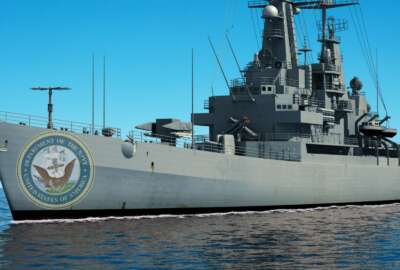

Navy leadership realized they will need new simulation facilities after a 2017 review of collisions that killed 17 sailors.
A year and a half after 17 sailors were killed in naval collisions, the Navy is fully funding two new surface warfare simulation facilities to prevent future problems.
“We have a fully funded plan to build new navigation, seamanship and ship-handling training programs that are integrated,” said Vice Chief of Naval Operations Adm. Bill Moran Tuesday at the Center for Strategic and International Studies in Washington. “There are very modern simulation capacities that are pretty eye watering that exist today in naval aviation, they exist today in the littoral combat ship (LCS) program. If you’ve been through an LCS trainer, they are remarkable trainers. They are the best in the business. We should have that for every ship class in the Navy.”
One will be built in Norfolk, Virginia, and the other in San Diego, California.
“These are large buildings that are going to house multiple simulators of varying degrees of capability and in numbers that allow us to do more reps and sets for our commanding officers, our department heads and our sailors in the fleet,” Moran, who was recently nominated as the new chief of naval operations, said. “That, to me, will make the biggest difference over time in terms of proficiency, experience and the kinds of things we need.”
A comprehensive review of the incidents released in late 2017 found that ship simulators were not up to par.
“Low cost simulators do not sufficiently provide the fidelity to fully replicate the stresses of complex operations in high traffic areas,” the report states.
Moran said the simulations were below his expectations too.

The Navy already made some moves to better its simulation problems. The 2017 review found one issue leading to danger on the seas was communication between the bridge and combat information systems.
“We’ve created a bit of a Frankenstein,” Adm. Philip Davidson, the commander of Fleet Forces Command said last January. “There has not been good control of the bridge as a control room in and of itself, on the destroyers specifically, but on our cruisers as well.”
Davidson said vessels that were originally designed and built in the 20th century have had their bridges supplemented with a series of new 21st century navigation technologies that are also used by merchant vessels. However, there is no particular authority in charge of making sure those systems are easy to use, that one ship’s bridge configuration resembles another, or that the shore-side simulators used to train sailors match up with the systems that they’ll actually use when standing watch underway.
The awkward and user-unfriendly configurations stand in stark contrast to the CICs because a single organization, the Program Executive Office for Integrated Warfare Systems, is in charge of designing and equipping them.
Moran said the Navy has since “bolted on” CIC simulators to the existing bridge simulators.
“That is helping the instructors teach some basic communications,” Moran said.
He added that the current simulator infrastructure did not allow sailors to train as much as commanding officers would like, which is why the new buildings will come in handy.
Moran was quick to point out that simulators are a complement, not a replacement for at-sea time.
The Navy also took steps to better at-sea time for surface warfare officers.
“We changed the career paths for surface warfare officers so they go to sea more often and for greater periods of time,” Moran said.
Copyright © 2025 Federal News Network. All rights reserved. This website is not intended for users located within the European Economic Area.
Scott Maucione is a defense reporter for Federal News Network and reports on human capital, workforce and the Defense Department at-large.
Follow @smaucioneWFED
